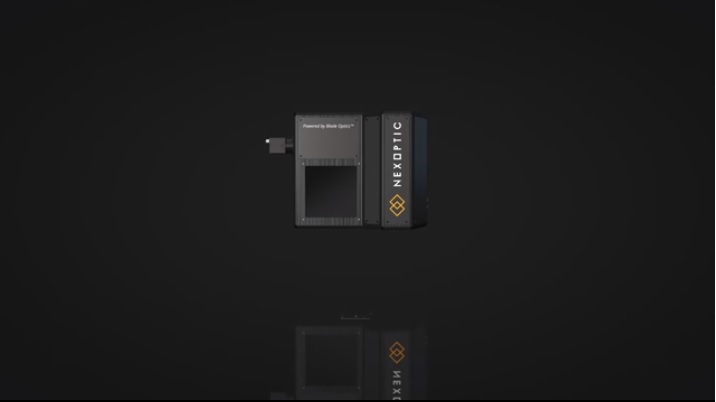Vancouver, Canada – June 7, 2017 - NexOptic Technology Corp. ("NexOptic") (OTCQB: NXOPF) (TSX VENTURE: NXO) (FRANKFURT: E301) (BERLIN: E301) and Spectrum Optix Inc. of Calgary, Canada ("Spectrum,") and together with NexOptic, the ("Companies") are pleased to announce that, further to their joint news release dated April 4, 2017, they have successfully completed the engineering trade study of a new telephoto lens stack design intended for mobile devices, including smartphones. Spectrum has filed a patent application with the United States Patent and Trademark Office (USPTO) related to its new design.
Completion of the engineering trade study is the first step in the Companies’ plan to expand their optical technology pipeline. Uniquely engineered, the new lens stack design incorporates a novel, mobile device optical system and builds on the benefits of the fundamental “compress before focus” approach of both the patent-pending Blade Optics™ and Diamond Blade Optics™ technologies. As outlined in the study, compressing light allows subsequent focusing elements to be compact while retaining high image quality. This approach opens up the possibility of a larger aperture within the given depth constraints of a mobile device.
The Companies believe this new telephoto lens stack design, with its relatively large aperture, has potential to provide high-resolution, long-range imaging for mobile devices.
Throughout the study, several designs were developed that satisfied a variety of technical specifications relating to focal length, f-number, field of view, aperture, sensor requirements, materials, and other high-level optical engineering design considerations typical for mobile devices. The broad range of designs are intended to provide potential customers with a baseline variety of lens stack performance options to best meet their specific requirements. Further, the Companies believe the design can be manufactured utilizing commonly used optical materials, demonstrating the potential for competitive costs when compared to the smartphone industry.
Anticipated Mobile Telephoto Lens Stack Design and Performance Improvements
Initial simulations indicate the optical performance of the new telephoto lens stack design could greatly improve angular resolution from existing consumer smartphone lens systems. The Companies’ initial design indicatesthe potential to double the light gathering area from the leading smartphone lens systems in the current consumer market.
John Daugela, President of Spectrum Optix and Director of NexOptic, said:
“Our goal with developing this smartphone demonstration prototype is two-pronged. First, we envision a telephoto lens stack that can be manufactured at a competitive price. Second, we aim to deliver a smartphone telephoto lens system that captures better images of objects at a distance than what is currently available in the market. A consistent critique of smartphone cameras is that they take poor-quality pictures of objects that are far away, and we aim to change that.”
Next Phase for Mobile Development
Spectrum has commenced the second phase in its mobile device prototype development program. This will include, but is not limited to, refining specifications based on industry feedback, completing detailed optical designs, defining various tolerances for its lens stack, and finalizing and sourcing materials and related components.
The Companies will follow a similar four-phase development program as conducted for the successful production of their proof-of-concept telescope prototype, which contains their patent-pending Blade OpticsTM technology.
The development of the new prototype and the application of Spectrum's technology to mobile devices is at a relatively early stage. Additional work, including further engineering and other studies, are required to complete the prototype and demonstrate the potential application of such technology for mobile and other devices, and its commercial potential. As such, there can be no assurance that the development of this application will be successful until such additional work is completed.
NexOptic Marketing and Technology Branding
For effective global marketing and widespread industry and consumer awareness, the Companies’ technology development portfolio will now fall under the Blade Optics™ brand. This includes all prior definitions and description such as Diamond Blade Optics™, flat lenses, and flat surface optical element systems. Blade Optics™ will be the trademark for the Companies’ pipeline of patent-pending optical technologies intended to increase aperture sizes within given depth constraints of various imaging and non-imaging optical applications.
Stock Option Grant
NexOptic also reports that it has granted an aggregate of 2,600,000 stock options to employees, directors and consultants having an exercise price of $1.75 and a term of five years.
About NexOptic Technology Corp.
NexOptic is a publicly traded company, which has an option to acquire, in the aggregate, 100% of Spectrum Optix Inc., a private corporation. The Companies are, in essence, working as a single corporation at this time, with their respective CEOs sitting on each other's boards of directors. Please see NexOptic's news release dated November 18, 2014 for additional details regarding this relationship.
Spectrum is developing technologies relating to imagery and light concentration applications. Utilizing Blade Optics™, its suite of patent-pending optical technologies, the company aims to increase aperture sizes within given depth constraints of various imaging and non-imaging optical applications.
Spectrum has completed its proof-of-concept digital (“POC”) telescope prototype that utilizes its patentpending Blade Optics™ technology, other optical elements and electronic components. The prototype is intended to demonstrate the marketable features of Spectrum's Blade Optics™ technology and its potential to serve as a platform to be used in various optical applications.
Benefits of Blade Optics™ Technology The Companies believe that Blade Optics™ has the potential to breakdown many of the limitations associated with conventional, curved lens stacks:
• Aperture size: Blade Optics™ may allow the aperture-to-depth ratio to be increased in depth-limited optical devices to permit increased resolution compared to conventional curved optical devices with similar depth.
• Compactness: Decreasing the depth of the lens stack would create the possibility of more compact and practical imaging devices.
NexOptic trades on the OTCQB under the symbol "NXOPF," on the TSX Venture as "NXO," on Frankfurt as "E301" and Berlin as "E301."
More information is available at www.nexoptic.com.















